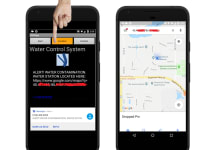
IoT Water Control Management (WCM) is a management system for water quality, control and distribution in poor regions. By winning this competition, we will build the final product and adapt water tanks in the Azraq and Kakuma refugee camp. We have a functional prototype already (see videos and pictures in the application).
The most recent report created in 2015 by UNHCR described an unprecedented 65.3 million people around the world forced from their homes. In a world where nearly 34,000 people are forcibly displaced every day, initiatives to improve their living conditions are more important than ever before. Azraq hosts a total of 53,833 people of concern originally from Syria. The Azraq camp opened in April 2014 to support Syrian refugees. Azraq camp is operated by the United Nations High Commissioner for Refugees (UNHCR). Kakuma Refugee camp is located in Kenya. Kakuma camp was established in 1992, and this camp represents a total 185,449 people from different countries living in fragile situation and waiting for better life quality.
Our project raised from real-world needs in refugee camps. Originally, our project was conceptualized to be implement in the Azraq refugee camp, where our team will be in charge to implement those changes and then, applied in the Kakuma Refugee Camp. Our team has members live in the Azraq refugee camp, Jordan camp and collaborators in the Kakuma refugee camp, Kenya. They are experiencing a lack of structure to have access to water so that they are not able to use water for planting or drinking. We are not working with assumptions. We are relying on a real problem in fragile settings, such as refugee camps. However, the number of refugee camps has been increasing over the last decades, and fragile settings (like favelas) are facing similar problems related to water and infrastructure.
Given the context in which our project was created, we strongly believe in the transferability of our concept since it is based on a real scenario that influenced the decision making for each technology used in this project. Before changing the world, we want to provide better life quality to 1.1 billion people living in extreme poverty condition or fragile settings by giving access to high-quality water as a resource for drinking and planting, for example.
Based on all constraints experienced by our members either in Jordan, Kenya, and Brazil, we came up with a solution that could minimize water problems in similar settings across the world. Therefore, we created the IoT Water Control Management. WCM seeks to build a reliable water system in poor regions through the measurement and control of water quality via mobile-web based system. WCM is an IoT-based mobile water access and quality monitoring system that provides water efficiency for all-purpose in poor regions. WCM delivers real-time measurement and monitoring of water quality at the point of origin where residuals affect the water. WCM can be installed at water tanks and yield data on water consumption and quality for continuous analysis through a statistical algorithm.
Video
-
Awards
-
 2018 Top 100 Entries
2018 Top 100 Entries
Like this entry?
-
About the Entrant
- Name:Claudio Freitas
- Type of entry:teamTeam members:Claudio Freitas, PhD Engineering Student
Hatem Mohammed, Student in Azraq Refugee Camp
Mohamad Obai, Student in Azraq Refugee Camp
William Freitas, Undergraduate, Mechanical Engineering
Samuel Filgueira, Undergraduate, Mechanical Engineering - Software used for this entry:AutoCAD
- Patent status:none








